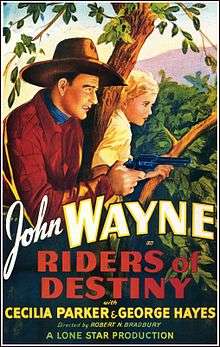Riders of Destiny
Riders of Destiny is a 1933 pre-Code Western musical film starring 26-year-old John Wayne as Singin' Sandy Saunders, the screen's second singing cowboy (the first being Ken Maynard in the 1929 film The Wagon Master). It was the first of a series of sixteen Lone Star Westerns made for Monogram Pictures between 1933-1935, by Wayne and director Robert N. Bradbury, and the first pairing of Wayne with George "Gabby" Hayes.
| Riders of Destiny | |
|---|---|
 Film poster | |
| Directed by | Robert N. Bradbury |
| Produced by | Paul Malvern |
| Written by | Robert N. Bradbury |
| Starring | |
| Cinematography | Archie Stout |
| Edited by | Carl Pierson |
| Distributed by | Monogram Pictures |
Release date |
|
Running time | 53 minutes |
| Country | United States |
| Language | English |
Notes
.png)
Wayne's singing voice was dubbed, and the film is considerably darker than the Gene Autry singing cowboy movies that followed it; for example, Singin' Sandy's ten-gallon hat was black instead of white and he would grimly chant about "streets soon running with blood" and "you'll be drinking your drinks with the dead" as he strode purposefully down the street toward a showdown. Equally dark, the bad man in the film says he has made the ranchers "an offer they can't refuse." The supporting cast includes George "Gabby" Hayes, the acrobatic comedian Al St. John, and the stuntman Yakima Canutt. The movie was written and directed by Robert N. Bradbury. It was the first of the Lone Star Productions released through Metro Goldwyn Mayer. The actual singer, who was singing as this film and Lawless Range were being made, was Bill Bradbury, son of director Robert N. Bradbury and brother of Robert A. Bradbury a.k.a. Bob Steele. Glenn Strange did the singing in Lawless Range.
Wayne's dubbed singing, which bore no resemblance to his unique speaking voice, was the reason he soon abandoned the singing cowboy format, as he later played a singing cowboy—though not Singin' Sandy—at least once, in Lawless Range, but he was embarrassed during personal appearances when he couldn't accommodate children who clamored for a Singin' Sandy song. Gene Autry was chosen by the studio as Wayne's replacement in the new genre, immediately solving the live singing problem while ushering in a much lighter take on the format than Wayne's grimly intense rendition.
Cast

- John Wayne as Singin' Sandy Saunders
- Cecilia Parker as Fay Denton
- Forrest Taylor as James Kincaid
- George "Gabby" Hayes as Charlie Denton (billed as George Hayes)
- Al St. John as henchman Bert
- Heinie Conklin as henchman Elmer
- Yakima Canutt as henchman
- Earl Dwire as Slip Morgan
- Lafe McKee as Sheriff Bill Baxter
- Addie Foster as Mrs. Mason
- Silver Tip Baker as townsman (uncredited)
- Horace B. Carpenter as rancher (uncredited)
- William Dyer as rancher (uncredited)
See also
External links
| Wikimedia Commons has media related to Riders of Destiny. |
- Riders of Destiny on IMDb
- Riders of Destiny is available for free download at the Internet Archive
- Riders of Destiny at Rotten Tomatoes